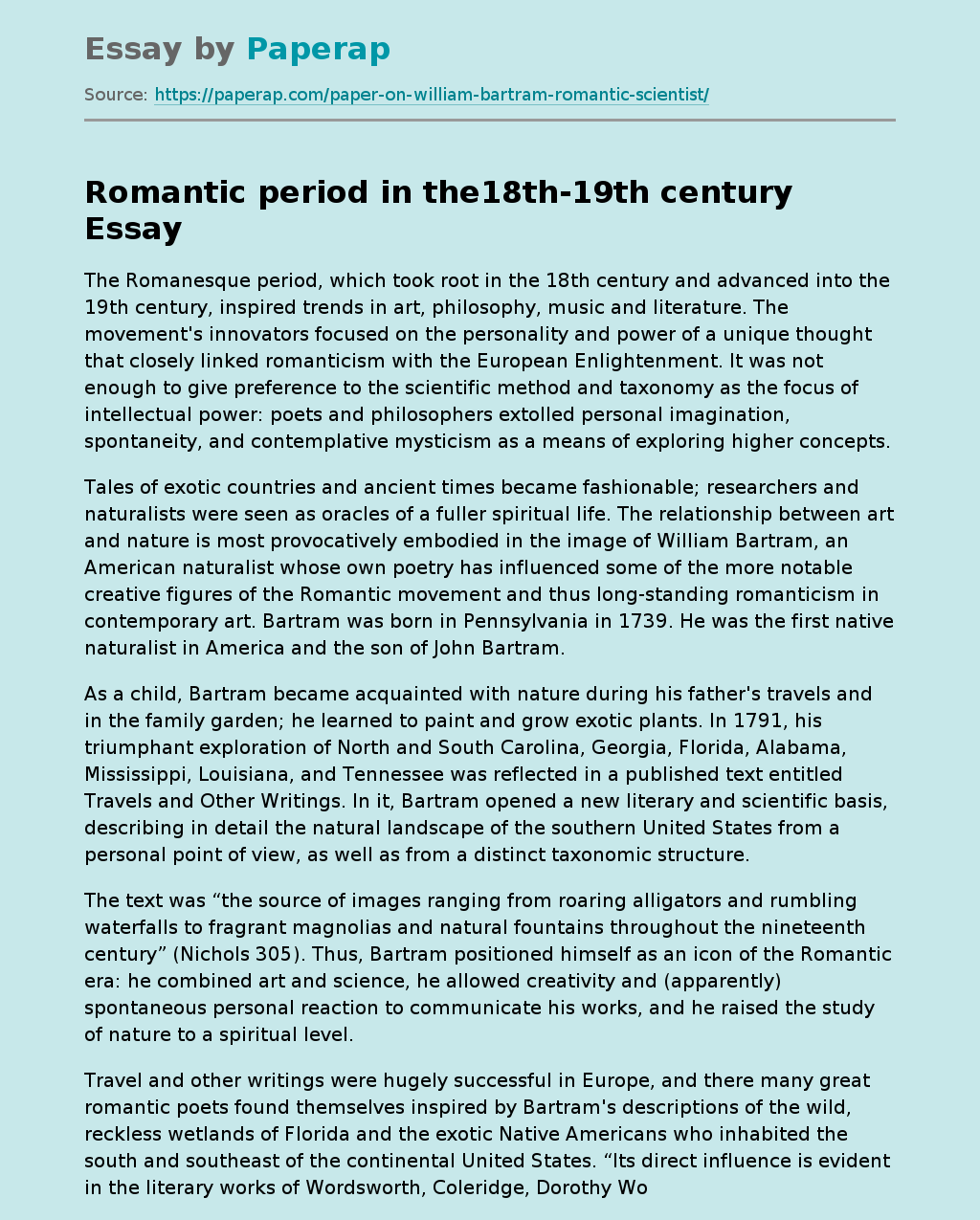Romantic period in the18th-19th century
The Romanesque period, which took root in the 18th century and advanced into the 19th century, inspired trends in art, philosophy, music and literature. The movement’s innovators focused on the personality and power of a unique thought that closely linked romanticism with the European Enlightenment. It was not enough to give preference to the scientific method and taxonomy as the focus of intellectual power: poets and philosophers extolled personal imagination, spontaneity, and contemplative mysticism as a means of exploring higher concepts.
Tales of exotic countries and ancient times became fashionable; researchers and naturalists were seen as oracles of a fuller spiritual life. The relationship between art and nature is most provocatively embodied in the image of William Bartram, an American naturalist whose own poetry has influenced some of the more notable creative figures of the Romantic movement and thus long-standing romanticism in contemporary art. Bartram was born in Pennsylvania in 1739. He was the first native naturalist in America and the son of John Bartram.
As a child, Bartram became acquainted with nature during his father’s travels and in the family garden; he learned to paint and grow exotic plants. In 1791, his triumphant exploration of North and South Carolina, Georgia, Florida, Alabama, Mississippi, Louisiana, and Tennessee was reflected in a published text entitled Travels and Other Writings. In it, Bartram opened a new literary and scientific basis, describing in detail the natural landscape of the southern United States from a personal point of view, as well as from a distinct taxonomic structure.
The text was “the source of images ranging from roaring alligators and rumbling waterfalls to fragrant magnolias and natural fountains throughout the nineteenth century” (Nichols 305). Thus, Bartram positioned himself as an icon of the Romantic era: he combined art and science, he allowed creativity and (apparently) spontaneous personal reaction to communicate his works, and he raised the study of nature to a spiritual level.
Travel and other writings were hugely successful in Europe, and there many great romantic poets found themselves inspired by Bartram’s descriptions of the wild, reckless wetlands of Florida and the exotic Native Americans who inhabited the south and southeast of the continental United States. “Its direct influence is evident in the literary works of Wordsworth, Coleridge, Dorothy Wordsworth, Shelley, John Keats, and many others,” including direct attributions of Coleridge and Wordsworth, which “went so far as to footnote Bartram to write down his debt. to represent the fabulous cypress spire ”(Nichols 305-6).
Bartram brought the myth of the great American frontier to life for European readers by placing in their hands (most likely in comfortable chairs) stories of natural wonders that were both accessible and surmountable. This legendary territory was rendered in Bartram’s natural lyric language. A vivid writing style combined with careful observation to create vivid images of the natural wonders of the New World ”(Nichols 305-6).
Bartram significantly influenced how the greatest of romantic poets interpreted the sublime aspect of nature and how they gained access to the wild American landscape. “His prose is full of lyrical descriptions, sensual language and metaphors worthy of a poet. Moreover, his rhetorical technique combines remarkably accurate field observations with the ability to connect these details through imaginative and analogous thinking ”(Nichols 306).
His legacy was immortalized not only by generations of naturalists and botanists, but also by poets and philosophers who continued the creative romantic movement. His understanding of the inherent provocative element of nature inspired others to further develop metaphors.
Romantic period in the18th-19th century. (2019, Dec 05). Retrieved from https://paperap.com/paper-on-william-bartram-romantic-scientist/

